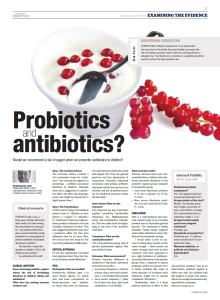 This article was published in Medical Observer.
This article was published in Medical Observer.
The article is also available on the Medical Observer website (may need registration).
Clinical scenario
I recently saw Leon, a 3-year-old boy suffering from acute otitis media. As I was writing the prescription for amoxycillin, I remembered that there was a recent Australian study published on using yoghurt to prevent antibiotic-associated diarrhoea in children. [1] The last time I asked the question in adults in 2013, the evidence was unclear. [2] So, what about for kids?
Clinical question
Does consuming probiotic yoghurt reduce the risk of developing diarrhoea, in children taking oral antibiotics?
What does the existing research evidence say?
Step 1: The Cochrane Library
The Cochrane Library contains a 2011 systematic review for “probiotics” (not necessarily yoghurt) in preventing antibiotic-associated diarrhoea in children. Although there was a suggestion of a protective effect, the effect was heterogeneous and might be biased due to high dropout rates. [3]
Step 2: The Trip Database
A PICO search using the TripDatabase (search term: P: “children on antibiotics”, I: “yogurt”, C: “placebo”, O: “diarrhoea”) found an evidence-based position statement from the Canadian Paediatric Society. [4] This also suggested that probiotics may have a protective effect but that poor adherence may be an issue.
Now, let’s look at the new study by Fox et al. (2015) published in BMJ Open! [1]
Critical appraisal
I will use the randomised controlled trial appraisal sheet from the Centre for Evidence Based Medicine. [5]
PICO
Participants: who was studied?
72 children aged 1 to 12 years (mean: approx. 6 ½ years), who had been commenced on broad-spectrum oral antibiotics (more than 90% on β-lactams), recruited between Sep 2009 and Aug 2012 from two general practices and four pharmacies in Launceston, Tasmania. Important exclusions: milk allergy, antibiotic treatment within the previous 2 months, and use of probiotic product for medicinal purposes within the last week.
Intervention: what was the exposure?
2 x 100 gram tubs per day of probiotic yoghurt containing Lactobacillus rhamnosus GG, Bifidobacterium lactis, and Lactobacillus acidophilus. This was taken from the beginning to the end of the antibiotic treatment.
Comparator: what was the control/alternative?
2 x 100 gram identical looking tubs of placebo pasteurised yoghurt that were similar in taste.
Outcomes: what was measured?
Primary outcome: difference in incidence of “diarrhoea”, defined at two levels of severity [1]
- less severe: frequency ≥ 2/day for at least 2 days, with stool consistency ≥ 5 on the Bristol Stool Scale (BSS)
- more severe: frequency ≥ 3/day for at least 2 days, with stool consistency ≥ 6 on the BSS
Internal validity: are the trial results valid?
Randomised patient assignment?
Yes. This appeared well performed and described (p. 2) [1]
Groups similar at the start?
Mostly. The placebo group had a higher proportion of boys, and children on below the recommended dose of antibiotics (Table 1, p. 3). [1]
Groups treated equally apart from assigned treatment?
Probably, yes.
All patients accounted for?
Effectively yes. 72 children were recruited and 70 completed the study.
Measures objective? Or patients and clinicians kept blinded?
Yes.
What were the results?
Primary outcome: there were substantially fewer children with antibiotic-associated diarrhoea in the probiotic yoghurt group as compared to the placebo yoghurt group.
- Less severe diarrhoea: probiotic (1 of 34) vs placebo (21 of 36), P < 0.001
- More severe diarrhoea: probiotic (0 of 34) vs placebo (6 of 36), P = 0.025
Conclusion
This is a lovely, well designed and powered clinical study, of an everyday problem seen in Australian general practice. Moreover, the treatment is widely available (“Vaalia” brand yoghurt) and is likely tolerable to many children in the community setting. Fantastic!
I would make a note of caution in taking these results at face value though – these results are rather stronger than seen in prior research [3], and there appeared to be a high incidence of antibiotic-associated diarrhoea in the placebo group (75%), [1] compared to typical estimates which are around 10%. [6] It seems probable that some of these episodes of increased stool frequency might not be usually considered “diarrhoea”.
Nonetheless, there is a fairly uniform direction of effect in this and previous studies, [1-3] and as an intervention probiotic yoghurt is likely very safe. For children who like yoghurt (and Leon did), it seems very reasonable to encourage this measure during antibiotic treatment.
Stat Facts
Bonferroni correction
Conducting multiple comparisons in an experiment (as was done in this study) increases the risk of finding a positive result, when the null hypothesis is actually true. The Bonferroni correction is a statistical method used to control the false positive rate.
References
- Fox MJ, Ahuja KD, Robertson IK, Ball MJ, Eri RD. Can probiotic yogurt prevent diarrhoea in children on antibiotics? A double-blind, randomised, placebo-controlled study. BMJ Open 2015;5(1): e006474. DOI: 10.1136/bmjopen-2014-006474
- Tam M. Is yoghurt helpful for antibiotic-associated diarrhoea? Medical Observer 2013 May 17: 30
- Johnston BC, Goldenberg JZ, Vandvik PO, Sun X, Guyatt GH. Probiotics for the prevention of pediatric antibiotic-associated diarrhea. Cochrane Database of Systematic Reviews 2011; Issue 11. Art. No.: CD004827. DOI: 10.1002/14651858.CD004827.pub3
- Using probiotics in the paediatric population [website]. Canadian Paediatric Society [updated: 2012 December 3]. Retrieved on: 2015 February 13. Available from: http://www.cps.ca/en/documents/position/probiotics-in-the-paediatric-population
- RCT Appraisal Sheets [website]. Centre for Evidence Based Medicine. Retrieved on: 2015 February 13. Available from: http://www.cebm.net/critical-appraisal/
- Turck D, Bernet JP, Marx J, et al. Incidence and risk factors of oral antibiotic-associated diarrhea in an outpatient pediatric population. Journal of Pediatric Gastroenterology and Nutrition 2003;371(1): 22-26
